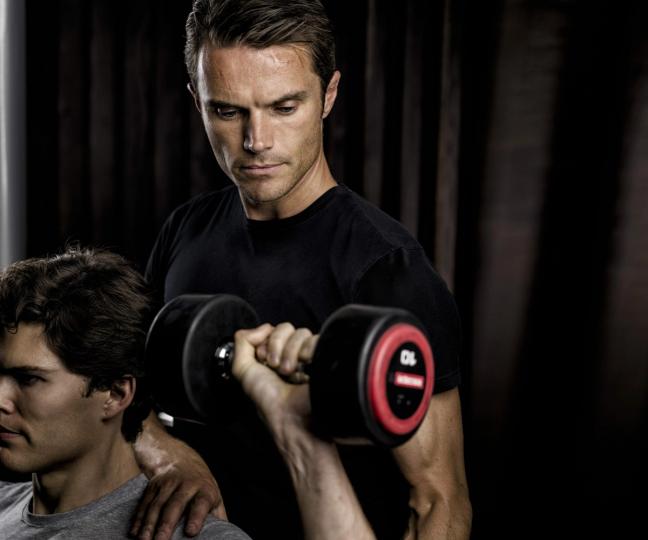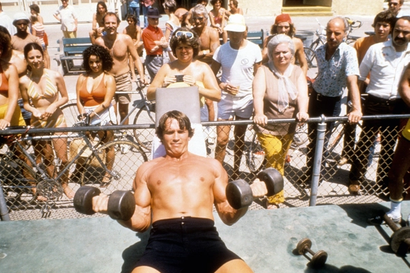For most men, building a beach body often means two things – adding muscle and losing fat. The best way to achieve this will forever be debated as it depends on a multitude of factors – including the body weight and composition with which you are starting, your training history and your nutritional practices.
However, for most recreational exercisers, focusing on the basics consistently is often enough to make a marked difference – and sticking to a schedule of regular exercise needs to be your priority. Often, when we make things too complicated or demanding, the likelihood of missing sessions or quitting all together goes up.
With this in mind, over the next 10 weeks I’ll offer some simple muscle building tips for each of the key parts of the body along with some nutritional guidelines to help keep you on track as the summer approaches.

But, before we get started, it’s important to have an appreciation for three key variables when it comes to muscle building – volume, intensity and frequency.
These three variables are interrelated and virtually inseparable from one another. Depending on how you look at it, any one of these could be considered the most important as they all play a significant role in inducing the metabolic stresses and muscle tensions required for muscle growth. The optimal combination of each will vary depending on the person (age, goals, preferences, schedule etc.).

Adding an extra training day (i.e. increased frequency) can dramatically improve your overall training volume, after this a mixture of sets, reps and weights need to be gradually increased overtime.
Optimal rep ranges for maximal hypertrophy gains are usually set between 6-12 (this is a generalisation and may vary depending on muscle groups). When using a rep range it is important to remember that it is only likely elicit the desired outcome if the load (i.e. intensity) is appropriate. A good rule of thumb is to find a load that allows you to achieve the required rep range with good form and only have one or two reps “left in the tank” by then end of each set.
Starting recommendations:
– Volume: 40-70 reps/muscle group/session (80-210 reps/muscle group/week)
– Intensity: 65-75% of total volume in the 6-12rm range.
– Frequency: x2-3 per week per muscle group

This week we’ll kick things off with building the back. Key exercises to include in your program for maximal growth of the back muscles are:
– The pronated grip (knuckles facing you) lat pull down – this exercise is excellent for targeting the latissimus dorsi (lats). You can vary the grip between shoulder width and twice shoulder width to help fully stimulate the musculature.
– The neutral grip seated row – a neutral grip can reduce the amount of work from the biceps, allowing the midback muscles (middle trapezius and rhomboids) to carry out a greater amount of work.
– Single arm dumbbell row – this is a great exercise for evening out any left to right strength differences and when executed with an active reach into the bench with the support arm it can help to increase activation of serratus anterior, improving rib cage position to help work the mid back muscles through their full range.
In line with the recommendations above a possible set and rep scheme over the next 8 weeks could look like this: Week 1 – 3×8 (72reps/session, 144reps/week), Week 2 – 3x 10 (90reps/session, 180reps/week), Week 3 – 3×12 (108reps/session, 216reps/week), Week 4 (deload week), 2×10 (60reps/session, 120reps/week). Then repeat cycle for next 4 weeks aiming to add small increases to the weights used (don’t miss any reps though!). Aim to include these exercises into your training schedule twice each week.

Eat protein and vegetables at most, if not every meal – When a meal is made up of whole foods from these two groups it tends to be lower in calories, higher in fibre, higher in water and more satiating – keeping you feeling satisfied for longer. By focusing on high quality sources of protein and vegetables, you will find it much easier to keep your food quantity in check while still providing your muscles with the building blocks for growth and repair.
– Matt Roberts is a UK-leading personal trainer and best-selling fitness author. Learn more here.

Become a Gentleman’s Journal Member?
Like the Gentleman’s Journal? Why not join the Clubhouse, a special kind of private club where members receive offers and experiences from hand-picked, premium brands. You will also receive invites to exclusive events, the quarterly print magazine delivered directly to your door and your own membership card.


